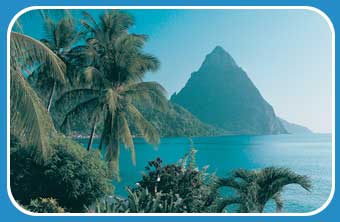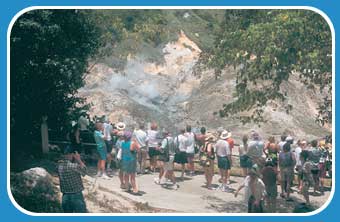The Land
St Lucia is a tropical mountainous island with an area of 610 km2. The island exists because the Caribbean plate is pushed up as the North American plate plunges beneath it. The area is tectonically active, and its volcanic features are important tourist attractions.
| The Piton peaks on St Lucia are among the most recogniseable landscapes in the region. These mountains rise from the sea to a height of 600 metres. |

©Philip Wolmuth/Panos Pictures.
|

©Garrett Nagle
|
Soufrière has been described as the world's only drive-in volcanic crater. At Soufrière, boiling sulphur springs continuously release heat and pressure. Once the sulphur springs stop bubbling they stop releasing pressure from beneath St Lucia. That's when local residents know that a disaster could be imminent. |
St Lucia's 'natural' vegetation is tropical rainforest. The trees and plants growing in this rich ecosystem grow in distinct layers, each forming a unique habitat for animals and other plants.
 to see if you can work out some of the characteristics of the different layers of the rainforest by dragging the boxes to the right places. to see if you can work out some of the characteristics of the different layers of the rainforest by dragging the boxes to the right places.
You will need Macromedia Flash player to view this exercise click on the icon to download it.

Download Time Estimate: 1 minute @ 56K modem
Tropical rainforests now cover only 11% of the land as people have cleared the forest to make way for settlements, roads and banana plantations. Today, the natural forest areas are largely confined to the more inaccessible interior.
The Climate
St Lucia has a warm, tropical climate, although the cooler North East Trade Winds blowing from the sub-tropics help to take the edge off the tropical heat. The dry season lasts from January to April and the wet season from June until October. Short heavy showers are typical in the wet season, and rainfall is up to three times greater in the centre of the island compared with the coast. Here, moist air is forced to rise, leading to relief rainfall.
 for a climate graph for St Lucia. for a climate graph for St Lucia.
The end of the wet season is also the time of year when hurricanes are a risk. Between August and October, these storms can build up in the Atlantic Ocean. In October 2001, Hurricane Iris caused extensive damage in St Lucia before it hit Belize and other parts of the Caribbean.
|





